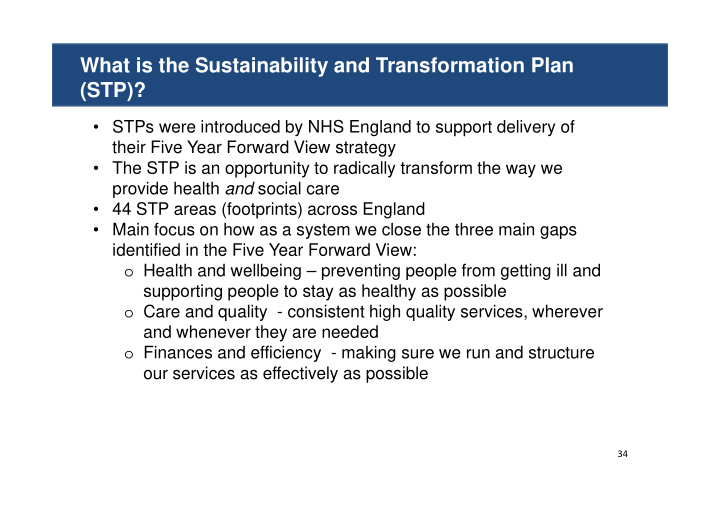



What is the Sustainability and Transformation Plan (STP)? • STPs were introduced by NHS England to support delivery of their Five Year Forward View strategy • The STP is an opportunity to radically transform the way we provide health and social care • 44 STP areas (footprints) across England • Main focus on how as a system we close the three main gaps identified in the Five Year Forward View: o Health and wellbeing – preventing people from getting ill and supporting people to stay as healthy as possible o Care and quality - consistent high quality services, wherever and whenever they are needed o Finances and efficiency - making sure we run and structure our services as effectively as possible 34
2 Health and social care in North West London is not sustainable Adults are not making healthy choices Increased social isolation Health & Wellbeing Poor children’s health and wellbeing Unwarranted variation in clinical practise and outcomes Care & Reduced life expectancy for those with mental health issues Quality Lack of end of life care available at home Deficits in most NHS providers Increasing financial gap across health and large social Finance & Efficiency care funding cuts Inefficiencies and duplication driven by organisational not patient focus. 20% of people have a long term condition 50% of people over 65 live alone 10 – 28% of children live in households with no adults in employment 1 in 5 children aged 4-5 are overweight Over 30% of patients in acute hospitals do not need to be in an acute setting and should be cared for in more appropriate places People with serious and long term mental health needs have a life expectancy 20 years less than the average Over 80% of patients indicated a preference to die at home but only 22% actually did 35
3 Health and social care in North West London is not sustainable Current Population Future Population (2030) % Increase 36
4 The North West London Vision – helping people to be well and live well Our vision of how the system will change and how patients will experience care by 2020/21 38
5 How we will close the gaps – 5 delivery areas Delivery areas (DA) Plans Triple Aim • Enabling and supporting healthier living DA 1 • Wider determinants of health interventions Radically upgrading prevention and • Helping children to get the best start in life wellbeing Improving • Address social isolation health & wellbeing • Improve cancer screening DA 2 • Better outcomes and support for people with common mental Eliminating unwarranted variation and health needs, improving LTC management • Reducing variation • Improve self-management and ‘patient activation’ Improving • Whole systems approach to commissioning • Implement accountable care partnerships care & DA 3 • Implement new models of integrated care services Achieving better outcomes and quality • Upgraded rapid response and intermediate care services experiences for older people • Single discharge approach • Improve care in the last phase of life • New model of care for people with serious and long needs DA 4 • Address wider determinants of health Improving outcomes for children &adults • Crisis support services Improving with mental health needs • Implementing ‘Future in Mind’ to improve children’s mental productivity health and wellbeing & closing the financial • Specialised commissioning to improve pathways from primary DA 5 care & support consolidation of specialised services gap Ensuring we have safe, high quality • Deliver the 7 day services standards sustainable acute services • Reconfiguring acute services • NW London Productivity Programme 39
Recommend
More recommend